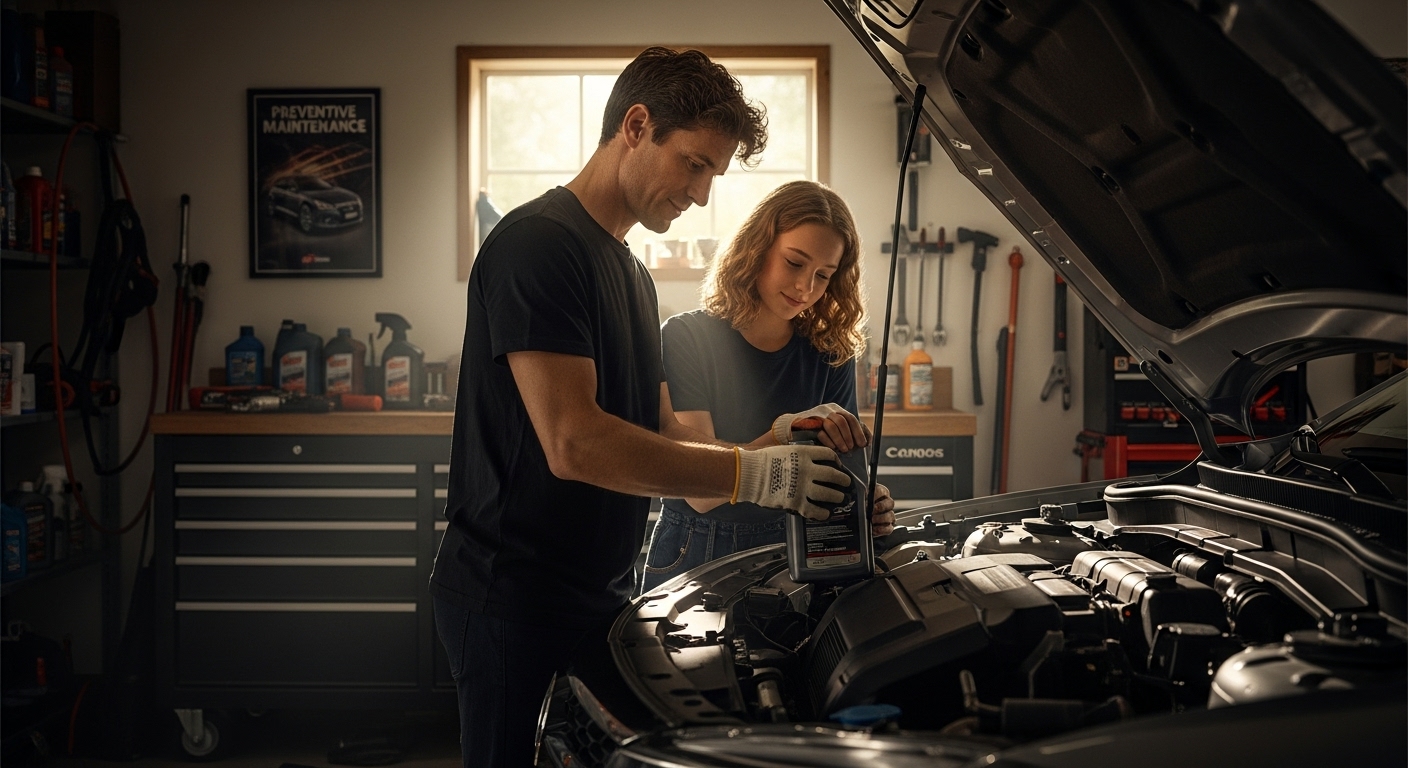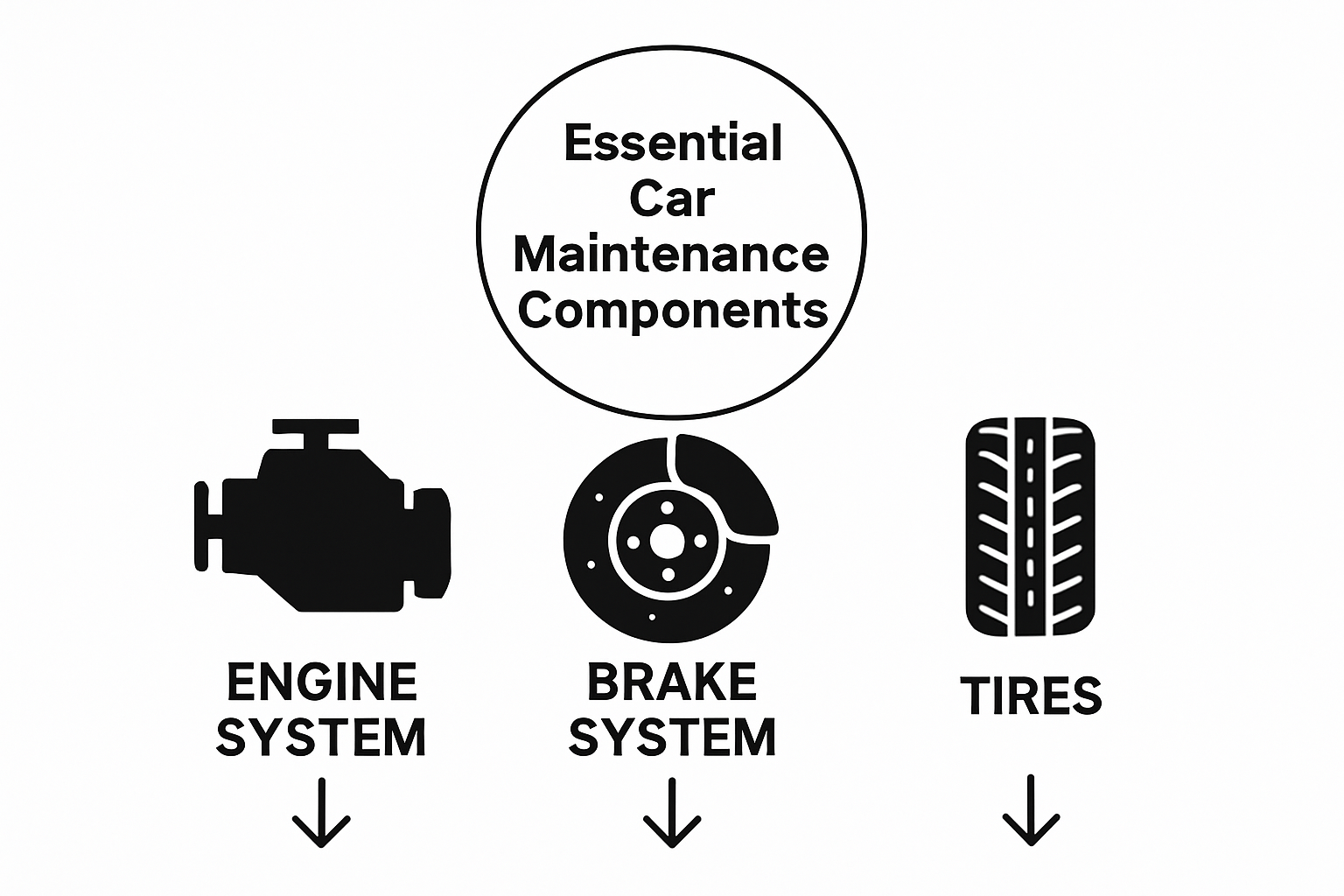Understanding Car Maintenance Basics for New Buyers
September 22, 2025
Everyone knows cars need care to run well and stay safe. Yet regular maintenance can actually save you up to 40 percent on long-term repair bills compared to just waiting for things to break. Most people focus on fixing problems after they pop up, but the real secret is that basic preventative care can make your car last years longer and keep you safer every mile.
Table of Contents
- What Is Car Maintenance And Why It Matters
- The Role Of Preventive Maintenance In Vehicle Longevity
- Essential Components Of Your Car That Require Care
- Understanding Common Car Problems And Solutions
- Budgeting For Maintenance And Repairs
Quick Summary
| Takeaway | Explanation |
|---|---|
| Regular maintenance saves money | Consistent car maintenance can reduce long-term repair costs by up to 40%, helping you save significantly. |
| Preventive care extends vehicle life | Vehicles with preventive maintenance can last up to 50% longer and improve fuel efficiency by 10-15%. |
| Stay alert for warning signs | Common indicators like check engine lights or unusual noises can prevent costly repairs when addressed early. |
| Budget for routine expenses | Establishing a dedicated maintenance savings fund can alleviate financial stress from car ownership costs. |
| Understand key components’ needs | Regular checks on critical parts like brakes and oil are essential for safety and performance longevity. |
What is Car Maintenance and Why It Matters
Car maintenance represents the ongoing series of systematic care and preventative actions designed to keep a vehicle running efficiently, safely, and reliably. At its core, car maintenance is about proactively addressing your vehicle’s needs before they transform into expensive, complex problems.
Understanding the Fundamental Purpose
Vehicle maintenance goes far beyond simple mechanical upkeep. It is a comprehensive approach to preserving your car’s performance, protecting your financial investment, and ensuring your personal safety on the road. Learn more about our vehicle maintenance checklist for new buyers to understand the depth of these essential practices.
Key aspects of car maintenance include:
- Regular fluid checks and replacements
- Monitoring tire pressure and tread condition
- Scheduled inspections of critical mechanical components
- Addressing warning indicators promptly
The Economic and Safety Implications
Properly maintained vehicles experience significantly fewer unexpected breakdowns and repairs. According to Consumer Reports, regular maintenance can reduce long-term repair costs by up to 40%. This translates into substantial savings and reduced risk of unexpected vehicle failures.
Beyond financial considerations, consistent maintenance directly impacts vehicle safety. Well-maintained cars have more predictable performance, better handling, and lower risks of mechanical failures that could potentially lead to accidents. By understanding and implementing basic car maintenance principles, vehicle owners transform their cars from mere transportation devices into reliable, long-lasting investments.
The Role of Preventive Maintenance in Vehicle Longevity
Preventive maintenance represents a strategic approach to automobile care that focuses on anticipating and addressing potential mechanical issues before they escalate into significant problems. Unlike reactive repairs, preventive maintenance is about proactively preserving your vehicle’s performance and extending its operational lifespan.
Understanding the Core Principles
At its heart, preventive maintenance involves systematic inspection, regular servicing, and timely replacement of critical vehicle components. This methodical approach helps identify minor wear and potential failures before they transform into costly, extensive repairs. Explore our guide on budgeting for car maintenance to understand the financial strategy behind these essential practices.
Key preventive maintenance strategies include:
- Regular oil and fluid level checks
- Scheduled tire rotations and alignment
- Comprehensive brake system inspections
- Timely replacement of wear-prone components
Economic and Performance Benefits
Research from Consumer Reports indicates that vehicles with consistent preventive maintenance can extend their operational life by up to 50% and improve fuel efficiency by 10-15%. This translates into substantial long-term savings and a more reliable driving experience.
Moreover, preventive maintenance directly impacts vehicle performance and safety. By addressing potential issues early, drivers minimize the risk of unexpected breakdowns, reduce overall repair costs, and maintain their vehicle’s optimal performance characteristics. The investment in routine maintenance is ultimately an investment in the vehicle’s longevity and the owner’s peace of mind.
To clarify the core differences between preventive maintenance and reactive repairs, the following table compares their primary focuses, benefits, and outcomes for car owners.
| Approach | Description | Key Benefits | Typical Outcomes |
|---|---|---|---|
| Preventive Maintenance | Proactively services and inspects the vehicle to catch issues early | Extends vehicle life, reduces long-term costs | Fewer unexpected repairs |
| Reactive Repairs | Addresses problems only after something breaks or fails | Minimizes immediate time investment | Higher risk of costly breakdowns |

Essential Components of Your Car That Require Care
Every vehicle consists of intricate systems and components that work together to ensure smooth, safe operation. Understanding these critical parts and their maintenance requirements is fundamental to preserving your car’s performance and longevity.
Engine and Powertrain Systems
The engine represents the heart of your vehicle, requiring meticulous and consistent care to maintain optimal functionality. Critical engine components demand regular attention to prevent premature wear and potential mechanical failures. Check out our road trip preparation guide for additional maintenance insights to understand comprehensive vehicle care strategies.
Key engine and powertrain components requiring routine maintenance include:
- Engine oil and filter
- Transmission fluid
- Coolant system
- Spark plugs and ignition system
- Drive belts and timing components
Chassis and Safety-Critical Systems
Beyond the engine, several interconnected systems directly impact your vehicle’s safety and performance. According to National Highway Traffic Safety Administration, regular inspection of chassis and safety systems can significantly reduce accident risks.
Essential safety and chassis components requiring consistent care encompass:
- Brake pads and rotors
- Suspension components
- Steering system
- Tire condition and alignment
- Wheel bearings
By understanding and proactively maintaining these critical vehicle components, drivers can ensure safer, more reliable transportation while minimizing unexpected repair costs and potential roadside emergencies.
The table below summarizes essential car components requiring regular maintenance, along with their main functions and the consequences of neglecting their care.
| Component | Main Function | Consequences of Neglect |
|---|---|---|
| Engine Oil & Filter | Lubricates engine internals | Increased wear, engine damage |
| Coolant System | Regulates engine temperature | Overheating, engine failure |
| Brake Pads & Rotors | Enables safe stopping | Reduced stopping power, hazards |
| Tires | Supports vehicle movement and handling | Poor traction, tire failure |
| Suspension System | Maintains ride comfort and stability | Compromised handling, rough ride |

Understanding Common Car Problems and Solutions
Vehicle ownership involves navigating a complex landscape of potential mechanical challenges. Recognizing and addressing these issues promptly can prevent minor inconveniences from escalating into costly repairs and potential safety risks. Understanding common car problems provides vehicle owners with the knowledge to make informed maintenance decisions.
Identifying Warning Signs and Early Detection
Modern vehicles are equipped with sophisticated diagnostic systems that communicate potential issues through dashboard warning lights and performance indicators. Early detection is crucial in preventing extensive damage and maintaining vehicle reliability. Learn about essential questions to ask your mechanic to better understand your vehicle’s health and potential problems.
Common warning indicators include:
- Check engine light activation
- Unusual engine noises or vibrations
- Decreased fuel efficiency
- Inconsistent acceleration
- Brake performance changes
Systematic Approach to Problem Resolution
According to Consumer Reports, most vehicle issues fall into predictable categories that can be systematically diagnosed and addressed. Understanding these problem areas empowers car owners to communicate effectively with mechanics and make informed repair decisions.
Typical problem areas requiring professional assessment include:
- Electrical system malfunctions
- Transmission fluid and component issues
- Brake system wear and deterioration
- Suspension and steering component degradation
- Cooling system inefficiencies
By developing a proactive mindset toward vehicle maintenance, drivers can transform potential problems into manageable maintenance opportunities, ensuring safer and more reliable transportation.
Budgeting for Maintenance and Repairs
Effective vehicle maintenance requires strategic financial planning. Understanding the potential costs associated with car care helps owners anticipate expenses, prevent unexpected financial strain, and maintain their vehicle’s long-term performance and value.
Establishing a Maintenance Financial Strategy
Proactive budgeting is crucial in managing vehicle maintenance costs. Vehicle owners should recognize that regular maintenance represents an investment in their car’s longevity and reliability. Explore smart strategies for saving money on car expenses to develop a comprehensive financial approach to vehicle ownership.
Key financial considerations for car maintenance include:
- Creating a dedicated maintenance savings fund
- Tracking historical maintenance expenses
- Understanding manufacturer recommended service intervals
- Comparing maintenance costs across different vehicle models
- Planning for potential unexpected repairs
Understanding Maintenance Cost Structures
According to AAA’s Annual Driving Costs Report, the average annual maintenance cost for a new vehicle ranges between $500 and $900, depending on the make, model, and age. Strategic planning can help mitigate these expenses and prevent more costly repairs down the line.
Typical maintenance expense categories to budget for:
- Routine service and oil changes
- Tire replacements and rotations
- Brake system maintenance
- Battery and electrical system checks
- Fluid replacements and system inspections
By developing a comprehensive financial strategy for vehicle maintenance, car owners can transform potential financial stress into a manageable, predictable aspect of vehicle ownership.
Ready to Make Smarter Moves as a Car Buyer?
Understanding car maintenance basics is only part of the puzzle for new buyers. You want a reliable vehicle and peace of mind, but if you are eyeing rebuilt title cars to save money and go further, you need a place where transparency matches your diligence. At ReVroom, every listing goes the extra mile. You get detailed accident history information and before-repair photos included with each car, so you know exactly where it has been and what you are considering. Get more power in your search and avoid expensive surprises everyone dreads.

Stop paying for reports and start driving with confidence. Explore how ReVroom sets a new standard of openness for rebuilt title cars. Take your first step by viewing real before and after listings and see how our platform puts knowledge—and negotiation—right into your hands. Experience car buying the way it should be, where your next vehicle’s journey is as clear as your own.
Frequently Asked Questions
What is car maintenance?
Car maintenance refers to the ongoing series of systematic care and preventative actions designed to keep a vehicle running efficiently, safely, and reliably. It involves regular checks and servicing to prevent potential issues and maintain the vehicle’s performance.
Why is preventive maintenance important for my vehicle?
Preventive maintenance helps identify minor wear and potential failures before they become significant problems. It can extend your vehicle’s lifespan and improve fuel efficiency while reducing the risk of unexpected breakdowns and costly repairs.
What key components require regular maintenance?
Essential components that need consistent care include the engine oil and filter, coolant system, brake pads and rotors, tires, and suspension system. Regular inspections and servicing of these parts are crucial for safe and reliable vehicle operation.
How can I budget for car maintenance and repairs?
Effective budgeting involves creating a maintenance savings fund, tracking historical expenses, understanding manufacturer recommended service intervals, and planning for potential unexpected repairs. This proactive approach helps manage costs and keep your vehicle in good condition.
Recommended
- Essential Vehicle Maintenance Checklist for Utah Car Buyers | ReVroom
- Buying a Used vs New Car: A Step-by-Step Guide for 2025 | ReVroom
- 7 Essential Questions to Ask a Mechanic | ReVroom
- Essential Car Buying Checklist for Budget-conscious Shoppers | ReVroom
- What Is Fleet Maintenance? A Comprehensive Guide - Apple Truck & Trailer
